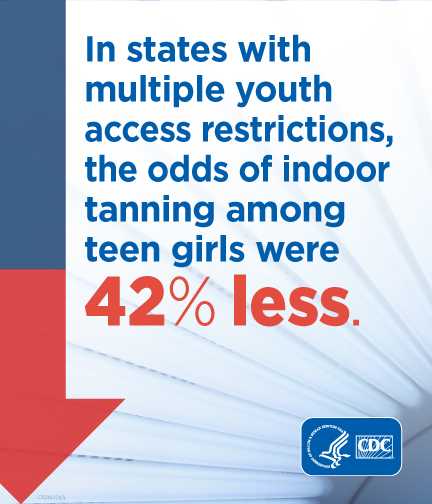Rates of indoor tanning among female high school students lowest in states with multiple restrictions on youth access
This website is archived for historical purposes and is no longer being maintained or updated.
Press Release
Embargoed for: Thursday, February 13, 2014, 4:00 ET
Contact: Media Relations
(404) 639-3286

In states with mulitple youth restrictions, the odds of indoor tanning among teen girls were 42% less.
Female high school students in states with indoor tanning laws, particularly those with parental permission laws and age restrictions, were less likely to engage in indoor tanning compared to students in states without any laws, according to a CDC study published online by the American Journal of Public Health.
Skin cancer is the most common form of cancer in the United States. Approximately 3.5 million cases of nonmelanoma skin cancers are treated annually, and over 60,000 melanomas are diagnosed annually. While most cancers have been on the decline since the 1990s, melanomas, which are the most fatal of skin cancers, have been on the rise, especially among young women. Increased exposure to ultraviolet radiation through indoor tanning may be partially responsible for the continued increase in melanoma.
Researchers, led by Dr. Gery Guy at CDC's Division of Cancer Prevention and Control, analyzed results of the 2009 and 2011 National Youth Risk Behavior Surveys of U.S. high school students in grades 9-12, and examined the details of each state's indoor tanning laws. Among high school students, 23.4 percent of females engaged in indoor tanning, and 6.5 percent of males engaged in indoor tanning.
Dr. Guy and his colleagues looked at state indoor tanning laws, and the relationship between teens' tanning behaviors and state laws. System access laws included warning statements and signs, limited advertising about the benefits of tanning, mandatory protective eyewear, operator-required incident reports, and penalties for violations. Youth access laws included parental permission for minors and age restrictions.
The odds of female students engaging in indoor tanning in states with any indoor tanning laws were 30 percent less than those in states without any indoor tanning laws. The odds of female students in states with systems access, parental permission, and age restriction laws engaging in indoor tanning were 42 percent less than those in states without any laws. Laws were not associated with the prevalence of indoor tanning for male youth.
States with laws that included systems access, parental permission, and age restrictions had the lowest rates of indoor tanning among teen girls. This is the first study to look at the impact of such laws on indoor tanning rates.
"State indoor tanning laws, especially age restrictions, may be effective in reducing indoor tanning among our nation's youth," said Gery Guy, PhD, health economist and the study's lead author. "We need to address the harms of indoor tanning, especially among children. Indoor tanning laws can be part of a comprehensive effort to prevent skin cancers and change social norms around tanned skin."
The numbers of states implementing new laws, particularly age restrictions, have increased substantially in recent years. Currently, six states (California, Illinois, Nevada, Oregon, Texas, and Vermont), restrict indoor tanning among minors aged younger than 18 years. A number of states are either considering new youth access legislation or strengthening existing laws.
The World Health Organization recommends that no one under the age of 18 years use indoor tanning. The Food and Drug Administration has proposed reclassifying indoor tanning devices from low- to moderate-risk devices. The proposed order advises against the use of indoor tanning among minors aged younger than 18 years.
For information about CDC's efforts in skin cancer prevention, visit http://www.cdc.gov/cancer/skin/.
The full study can be found at www.ajph.org on Thursday, February 13 at 4 p.m. ET. The printed version will be published in April.
- Page last reviewed: February 13, 2014 (archived document)
- Content source:
Error processing SSI file


 ShareCompartir
ShareCompartir